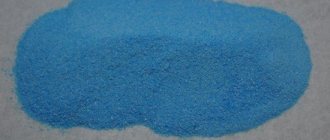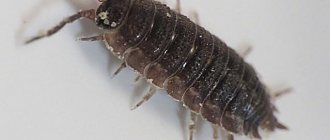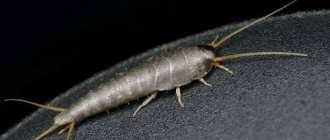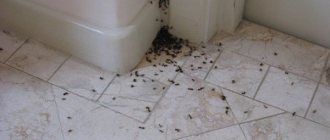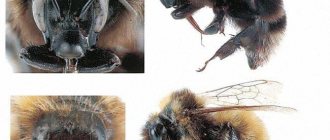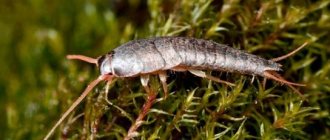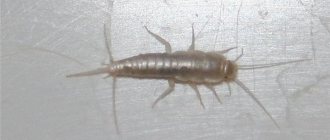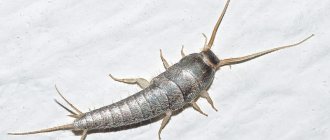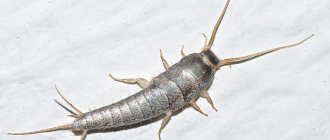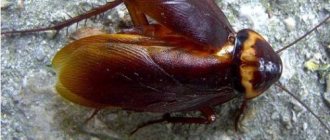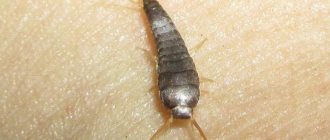The common silverfish or sugar silverfish (Lepisma saccharina) is a small insect that lives in apartments or houses. Many people do not notice it until the number of insects reaches 100-150 individuals. This is justified by the fact that this pest is invisible, in addition, the damage from it is quite insignificant.
Common silverfish (sugar silverfish)
Why do insects appear in the bathroom?
The main reason for the appearance of these creatures in the toilet and bathroom is high humidity. There is an increased risk of insects in apartments where major renovations have not been carried out for a long time, plumbing leaks and there are cracks in dark corners. However, these centipedes do not only start from dampness.
Both long and small centipedes love high air temperatures. Failure to comply with sanitation rules is often enough for bugs to appear. An overflowing trash can attracts silverfish. Favorable conditions for this living creature are created by poor ventilation in the house.
Silver and white silverfish
It is difficult to get a good look at a living silverfish, because... it moves quickly, but in the photo you can see the body structure of these creatures. Both white and silver silverfish are found in human homes. These varieties differ only in color. Some insects have a dark gray or black carapace, but have a shiny silver coating on top.
The structure of silverfish.
Other varieties of silverfish have a transparent white shell. It also has a silvery patina.
Adults look like tadpoles. The head is large and the tail is thin. There are long mustaches on the head. These creatures have 4 pairs of main legs and 8 pairs of auxiliary legs. Thanks to the special structure of their limbs, silverfish crawl quickly both along the floor and along the walls.
The favorite habitats of these insects are:
- far corners under the bathtub;
- places where condensation accumulates;
- hidden communications;
- jars of detergents;
- wet towels, mats and sponges.
These places have something in common - high humidity. Here, adult individuals live and also lay eggs, from which not too long white worms emerge. They look like thin caterpillars. They cannot run fast, so they are most often found in places where wet, caked clothes or towels have been left for a long time, as well as in the far corners of the bathroom, where cleaning is not done often.
Insects feed on organic matter . They consume mold, mucus, toilet paper, food scraps, natural fabrics, wallpaper paste, etc. Thus, these creatures can find enough food in the bathroom.
Appearance of silverfish
To notice such a small and inconspicuous insect, you should familiarize yourself with its external characteristics. Adults reach a body length of up to 1.9 cm (without antennae). Because they grow throughout their lives, the size of most silverfish ranges from 0.8 to 1.2 cm.
The body of the pest is quite flat, the head barely stands out against the background of the rest of the body. The chest is wide. The body gradually tapers towards the tail, and also has a subtle division into segments. It is covered with scales that change color during the molting process.
The most common type of silverfish is the common silverfish or sugar silverfish.
Among the shades are:
- dark brown (up to almost black);
- pale brown or dirty yellow (more common in young insects);
- light yellow or white (relatively rare color);
- silver (the body of such a representative has a bright, cold tint).
The silverfish has long, thick antennae that point forward and diverge slightly to the sides. In addition, a distinctive feature of this insect is the three threads at the end of the tail. These threads are extremely similar to antennae. The silverfish has three pairs of short but thick legs. The eyes of the pest are complex, faceted.
Danger and harm to humans
Silverfish have a weak mouthparts, because... They feed on soft, rotten organic matter, so they are unable to bite through human skin. At the same time, if such an insect crawls around the bathroom, it can cause an attack of fear and other unpleasant sensations.
Silverfish are not capable of biting humans, but are carriers of the fungus.
In addition, silverfish can act as carriers of fungus and pathogenic bacteria. They can harm indoor plants and spoil vegetables stored in the kitchen or on the balcony.
Description of the pest
Silverfish are very often observed in the bathroom because they love moisture. Such an insect survives in almost any conditions, so if you do not get rid of the pest, it will become a permanent resident of your apartment.
Essentially, it is a small insect with an oblong body and many legs , thanks to which the silverfish moves very quickly. The common and sugar varieties have antennae located at the front and back. It's not easy to catch her in the bathroom on your own, because she runs away as soon as someone notices her.
The basis of the diet of this insect is represented by paper, starch, food debris, and synthetic fabrics. If we talk about the sugar species, then this insect prefers sweet food.
It is worth noting that there are many types of silverfish. They are divided depending on the shade. So, there are silver, yellow, transparent and greenish silverfish. In apartments you can most often find sugar, silver and ordinary varieties.
This pest is very prolific, so it will multiply quickly if measures are not taken to destroy it. If you notice an insect in the bathroom, be sure to use a special product.
Fighting methods
To get rid of silverfish, you can use various folk and chemical remedies. In addition, it is recommended to use the services of professionals. After eliminating silverworms, you need to make sure that they do not appear again.
Physical methods
There are different ways to combat silverfish.
To prevent silverfish from living in the bathroom, it is necessary to reduce the humidity. You should carefully inspect the pipes to identify leaks and repair them.
All rooms where insects were previously identified should be thoroughly cleaned and treated with bleach. After the walls and floors have dried, they must be coated with a solution of copper sulfate. This will destroy the silverfish eggs. You should open the bathroom so that the air in it becomes drier. It is advisable to install a forced ventilation system.
All rugs, towels and other things that were in the bathroom must be washed and dried in the sun. It is recommended to throw away items that are very damp.
Traps and bait
The favorite place of silverfish is wet birch brooms.
Traps and baits are odorless. They are convenient to use in cases where there is a possibility of adult silverfish entering from the basement or attic. You can make traps yourself. These insects love to hide in wet birch brooms. They should be placed in the bathroom at night. In the morning, the brooms should be thrown away.
In addition, traps made of glass jars help against these insects. Pour 2-3 drops of honey into the container. The outer surface of the jar is covered with paper. Insects will easily climb into the container, but will not be able to get out. You can use paper as a trap. It should be rolled into a roll that is not too tight and wet. The trap is placed under the bathtub at night. It needs to be thrown away in the morning.
Chemicals
There are many chemical preparations in the form of powders, sprays and gels that can quickly remove silverfish, cockroaches, fleas and other insects. You can use Raid, Combat, Dichlorvos Varan. These products are available in the form of an odorless spray. After using such drugs, be sure to ventilate the room.
The insecticide Tarax helps get rid of silverfish quickly . It is also effective against woodlice, centipedes, bedbugs and other insects.
Gel-form preparations often used to eliminate these creatures include Antiinsect. This remedy is harmless to humans, like the drugs Gettor and Clean House.
Folk remedies
Red pepper and tobacco help to quickly remove silverfish. To prepare the composition you need to mix 5 tsp. soda, 1 tsp. tobacco and 1 tsp. ground red pepper. The mixture must be diluted with 1 liter of warm water. The resulting product is used to treat the walls and floor of the bathroom. After this, you need to rinse the surfaces with water and bleach and ventilate the room well.
You can fight these insects with boric acid. The product is sold in powder form. Up to 25 g of this substance dissolves in 1 liter of warm water. The resulting mixture is used to treat areas under the bathtub and sink. The room is ventilated after the procedure.
You can use salt to repel silverfish. It is scattered in paths under the baseboards in the bathroom and toilet.
Boric acid to combat silverfish.
In addition, it is recommended to regularly wash floors, walls, furniture and bathroom fixtures with water containing citrus and lavender essential oils. This helps repel silverfish.
Life cycle and lifestyle of silverfish
Silverfish are nocturnal. During the daytime, adults hide or look for a place to lay eggs. At the moment, insects live mainly in human homes, but there are also wild representatives. The latter feed on algae, fungi, fallen leaves or lichen, hiding inside the bark or under the forest floor.
It should be noted that the most common species is the common silverfish, which is also called “sugar fish”. It received this name because of the insect's craving for sweets. This is justified by the fact that silverfish need glucose. Starch is also very important for it.
Despite the fact that the pest is omnivorous, it has some taste preferences:
- Human food. Often this is sugar, flour (both potato and wheat) or vegetables. The insect can lay eggs in cereals, because this place seems quite safe to it.
- Various things and objects. Silverfish can feed on clothing or books, or more precisely on fabrics, leather, and also wool. The pest especially loves starched linen.
- Decoration of the premises. Starting from old wood to glue. Most often, the diet includes wallpaper and upholstery.
This animal stands out for its gluttony. Moreover, it can live without food for up to 10 months. The main condition for survival for an insect is humidity. For this reason, silverfish often settle in the bathroom or toilet.
Any crack can become a refuge for a pest. Silverfish also settle under scraps of wallpaper, garbage, or directly in food (primarily flour). You can often see it under the sink or bathtub, where it is quite dark, warm and humid. Since the insect hates light, it is almost impossible to meet it during the daytime: the silverfish, even if it is busy reproducing, moves exclusively in darkened areas.
Although the pest is extremely demanding of humidity, it does not need water. Moreover, it is dangerous for this insect. The silverfish cannot swim and drowns when it gets into a drop of water. This is justified by the structure of its legs: they are too short for the animal to get out of the liquid.
In nature, silverfish travel long distances. She develops high speed, but gets tired quickly. Because of this, the insect moves quickly, taking short breaks. The pest spends a lot of time reproducing, so speed of movement is extremely important for it. The reason for this is the fact that direct mating between individuals of different sexes does not occur. The female looks for spermatophores left by males in a random place.
Silverfish are considered insects prone to rapid and efficient reproduction. The female lays about 70 eggs at a time. The percentage of surviving larvae is quite high, and they grow quickly.
The molting process is important for silverfish. In larvae, scale changes occur more frequently. In addition, the number of molts of this insect is unlimited. The change in color can be quite radical, and also does not always depend on the age of the individual.
Prevention of insects
Silverfish are sensitive to environmental factors. To prevent them from starting up in the bathroom or toilet, you need to take care to reduce the humidity in these rooms. Do not dry wet laundry here. It is recommended to install additional heating and ventilation systems.
After each bath in the shower or bath, you need to remove condensation from the walls . You should regularly dry damp corners with a fan heater. It is recommended to treat the room with a solution containing chlorine. Bathrooms and toilets need to be ventilated frequently.
Reasons for appearing in the apartment
Before you understand how to deal with unwanted insects, you need to understand why they might appear in a living space.
- The reason for the appearance of insects may be the comfortable conditions for them in your apartment. This is high humidity, darkness and heat. The bathroom fits the description perfectly; owners often notice unpleasant neighbors there.
- Often insects enter the home from outside. They can come from neighbors through pipes, or crawl in from the street through an open window. However, they will reproduce and live only if they find suitable conditions for themselves.
- You can easily bring insects with you. Thanks to their small size, they fit safely into bags, packages, pockets, etc.
Chemical destruction of silverfish
If setting traps is not suitable for you, then you can use special chemicals to combat silverfish.
1. One of the most common means of removing insects is diatomaceous earth. Before going to bed, scatter it in places where you most often notice silverfish, and vacuum it up in the morning.
2. Another fairly effective remedy to quickly get rid of annoying silverfish is boric acid.
3. Pyrethrin-based insecticidal sprays help fight many insects, including silverfish. Cannot be used in areas where food is found and should be kept away from children and animals.
Using the above products, it is necessary to treat baseboards, cracks and other places where there are accumulations of insects.
4. Zest shavings can serve as a means of repelling silverfish by smell, however, it is worth noting that there is no talk of killing insects. It is not comfortable to constantly keep scattered powder in the apartment, so this method is only suitable for rooms where order is not so important, for example, basements and warehouses.
5. Another way to get rid of silverfish in the kitchen is to scare them away with a set of strong-smelling spices, placing them in cabinets. The spices of sage, cinnamon, bay leaf and others are quite suitable.
6. And finally, the last remedy that will make silverfish leave your bathroom is a citrus smell. You just need to buy a little lemon or lavender essential oil, dilute it in water and spray it on the places where insects have been noticed. This method is best suited to closed boxes and small, rarely used rooms - there the smell will not dissipate for a long time and will save you from pests, and it will also pleasantly delight you with freshness.
Preventive measures against the appearance of silverfish
- Silverfish will not settle in the bathroom if the room is constantly ventilated and ventilated, and any puddles that form on the floor are wiped off immediately.
- Old pipes become covered with condensation, and with poor ventilation, puddles form - an excellent place for insects to gather.
- Get rid of old papers and waste paper.
Book lovers! Thoroughly ventilate the room more often and monitor its microclimate, avoiding an increase in humidity.
- Seal any cracks where insects may hide. If mold appears, it should be dried and removed immediately. Read more about microwave drying of walls.
- Store food products in hermetically sealed jars, boxes, and containers.
Preventive measures for wood lice include keeping the bathroom clean and dry at all times. After taking a bath or shower, wipe the floors and walls dry, condensation accumulates there, which, together with dust, is an ideal habitat for silverfish.
Sugar silverfish: photo
There can be a huge number of species of insects in apartments, and before you start fighting them, you need to find out exactly what kind of parasites you are faced with. Silverfish have a number of external signs by which they can be distinguished from other moisture- and heat-loving household pests.
- The body of the silverfish has the shape of an oblong, flattened oval.
- Color varies from almost transparent to off-white, gray and brown.
- Convex eyes and several pairs of legs are often clearly visible in adults.
- There are long mustaches on the head.
- The tail is formed by a long needle-like filament and two cerci.
- The larvae hatch from eggs and almost immediately look like smaller copies of adults, but they are white and do not yet have protective chitinous coverings.
Silverfish can be confused with some other types of insects that are found in damp and warm places, in particular with woodlice
and some species of millipedes. To finally make sure that this is a sugar scalefish, look at the photo of the insect and compare it with the parasites found at home.
Accommodations
The reason why silverfish appear in the house is excessive humidity in the room - higher than 75%. Another thing that can contribute to this is if the room is warmer than 22 degrees. If the temperature is above 35 or below -10 degrees, the silverfish will die. However, it is possible to get rid of it once and for life. It can be done:
- independently (using a variety of folk methods and products sold in stores);
- calling a pest control team.
Despite its unpleasant appearance, silverfish are not dangerous to humans.
Habitats
These insects love dark and damp places. All rooms with high humidity and no ventilation are at risk. Ideal conditions for silverfish are humidity from 75% and temperature +21…27 ℃. In addition, these insects accumulate in large numbers where their favorite food is: paper, rags, bulk products or construction waste. Typical habitats:
- bathroom and toilet . Humidity and warmth are the most suitable conditions for most insects;
- utility rooms (laundry room, boiler room, pantry, etc.). And also all places where insects can find wet or old linen, wet rags;
- kitchen . Sugar silverfish will always find a treat in the kitchen: sugar, crumbs, cereals and starch;
- basement and cellar . If you don't clean basements and attics regularly, they will become a haven for insects;
- baseboards and window sills . Cracks in old wooden windows and baseboards are favorite habitats for white silverfish;
- book and linen closets . These insects are practically omnivorous and can find food everywhere. Their intestines contain enzymes that digest paper and turn it into nutrients. They will not disdain your home library, archives, stacks of old documents and newspapers. In linen closets they will feast on items made of silk, cotton, linen or viscose.
Insects often enter an apartment along with building finishing materials, old books and magazines. Given their ability to travel long distances and go months without food, you can bet they'll get inside your home at the first opportunity.
If there are a lot of pests, don’t expect them to voluntarily leave the premises - declare a fight against them. Let's take a closer look at how you can get rid of silverfish on your own.
How to get rid of silverfish
Effective control of insects can be carried out in various ways. The choice of method depends on the convenience and characteristics of the situation.
There are two most effective types of homemade traps for catching silverfish:
- In the first option, take a jar with a capacity of about a liter. The outside should be wrapped with electrical tape or masking tape, this is done so that insects can easily climb inside along the surface. There is bait inside, it could be a piece of sugar from their bread. The point is that pests will not be able to get back through the smooth walls of the jar.
- A newspaper or a stack of paper is rolled up and moistened with water. In this form, it is placed overnight in places where insects accumulate. During the night, the silverfish will penetrate the newspaper, and all that remains is to take it outside, or, even better, burn it.
You can also effectively use absolutely harmless insect repellents:
- Boric acid. The product is not harmless. It is dangerous if inhaled by both humans and pets. But at the same time, spraying problem areas with boric acid kills absolutely all insects. It should only be used using personal protective equipment.
- Dialomite powder. It’s not the most common remedy; it’s safe to say that many have never heard of it. This substance is also called mountain flour; it is made from rock. The product is harmless to humans and animals. The peculiarity is that the particles have sharp edges, therefore, after the particles are absorbed, the insects are injured from the inside.
- Citrus zest. Its smell is extremely unpleasant for silverfish, and they themselves will leave the place saturated with this aroma. The method, although long, is very effective and absolutely harmless, of course, provided that the person is not allergic to citrus fruits.
- Surviving unwanted guests from the kitchen is also quite simple; for this, absolutely harmless spices are used, such as cinnamon, cloves, and essential oils. Using this method is completely safe for stored products, but very effective.
Damage caused
Many people perceive silverfish as creatures that accidentally found their way into an apartment, completely unaware of how they are harmful to humans. Despite the fact that insects are not carriers of dangerous diseases, they can cause serious harm to the inhabitants of the home.
Silverfish are active in the dark, leaving their shelters and going in search of food. The insect's diet includes flour and sugar (which is why the pest is called the sugar silverfish), as well as starch and bone glue. Unpleasant-looking individuals can even satisfy their hunger with fabric made from natural fibers, books, magazines and newspapers. This love for paper products is explained by the presence of organic substances in book binding glue. Therefore, the presence of insects in the apartment, which are highly fertile, is fraught with damage to both food and things.
Common silverfish
On a note!
Sugar silverfish can go without food for several months, which complicates the process of fighting it.
What danger do they pose?
These arthropods do not bite and are not carriers of infection; they are harmless to animals and humans.
They can cause certain inconveniences, especially when their population is massive:
- Destruction of paper publications . Silverfish are great enemies for libraries and archives. This insect produces a specific enzyme that dissolves paper.
- Discomfort . A large number of individuals brings inconvenience and even spreads panic among household members.
- Dirt . Silverfish leave a huge amount of excrement that can end up in food and spoil it.
The omnivorous nature of such creatures is frightening. Arthropods actively destroy not only paper, but also fabric (they spoil clothes, curtains, linen), and food supplies. Therefore, if there are such domestic inhabitants, it is necessary to begin a fight against them. What to do with silverfish, how to get rid of them quickly and irrevocably?
